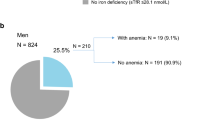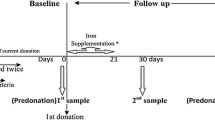Abstract
Iron status, i.e. serum ferritin and haemoglobin (Hb) levels, was assessed in a population survey in 1994 (Dan-Monica 10) comprising 1319 Caucasian Danish women in age cohorts of 40, 50, 60 and 70 years. In the entire series, ferritin levels increased significantly from 40 years to 60 years of age. The prevalence of small iron stores (ferritin 16–32 μg/l), depleted iron stores (ferritin <16 μg/l) and of iron deficiency anaemia (ferritin <13 μg/l and Hb <121 g/l) decreased steadily with age. Blood donors (n=109) had lower ferritin levels than non-donors (P<0.0001). Ferritin levels in donors were inversely correlated with the cumulated number of lifetime phlebotomies (r s =–0.25, P<0.01). Ferritin levels in non-donors (n=1208) were low in 40-year-old women (median 40 μg/l) and increased to a median of 95 μg/l in 60- and 70-year-old women (P<0.0001). In non-donors 40 years of age, the prevalence of small iron stores was 40.4%, the prevalence of depleted iron stores 10.8% and the prevalence of iron deficiency anaemia 2.16%. The prevalence of iron overload (ferritin >300 μg/l) was 1.54%. Ferritin levels in 60- and 70-year-old non-donors were correlated with the body mass index (r s =0.11, P=0.01). Ferritin levels in 50- to 60-year-old non-donors were correlated with alcohol intake (r s =0.23, P<0.0001). In the entire series, 37.5% of non-donors took supplemental ferrous iron (median 14 mg iron per day). Iron supplements had a significant positive influence on iron status in 40-year-old premenopausal non-donors but no effect in postmenopausal women or in donors. Non-donors (n=170) treated with acetylsalicylic acid had lower ferritin levels (median 55 μg/l) than non-treated (n=1038; median 75 μg/l) (P<0.0001). Compared with the Dan-Monica 1 iron status survey in 1984, the prevalence of iron deficiency and iron deficiency anaemia was unchanged, whereas the prevalence of iron overload displayed a slight increase. The 1987 abolition of the mandatory iron fortification of flour apparently had no negative effect on iron status.
Similar content being viewed by others
Author information
Authors and Affiliations
Additional information
Received: 8 November 1999 / Accepted: 17 April 2000
Rights and permissions
About this article
Cite this article
Milman, N., Byg, KE. & Ovesen, L. Iron status in Danes 1994 . Ann Hematol 79, 612–621 (2000). https://doi.org/10.1007/s002770000209
Issue Date:
DOI: https://doi.org/10.1007/s002770000209




